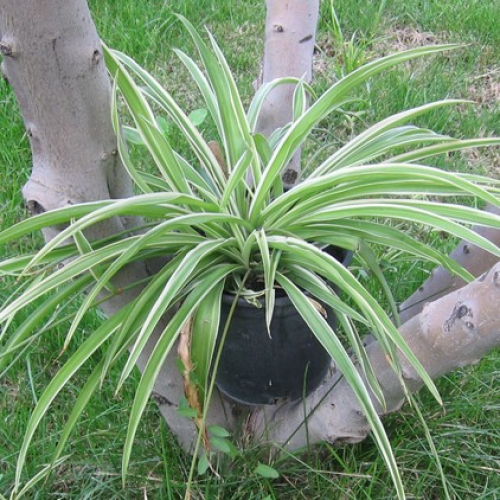Indoor plants Chlorophytum

Description
Characteristic Features of Chlorophytum
Chlorophytum is an herbaceous perennial plant of the lily family. In the wild, Chlorophytum grows in subtropical regions of Asia and Africa. Mature plants reach 60 centimeters and their slender, narrow leaves may grow to 70-75 centimeters long. Chlorophytum's flowers are small, usually white. The Latin name "Chlorophytum" means a "green plant". Indeed, a dense growth of Chlorophytum leaves abundantly growing from the center of the rosette forms a thick green canopy. The variegated form of Chlorophytum is especially popular. Its leaves have longitudinal light stripes, making it very attractive.
Spider Plant, Ribbon Plant, and Airplane Plant are some of Chlorophytum's common names that refer to its bizarre shape and are a product of great imagination of indoor plant enthusiasts. Today it is easy to buy Chlorophytum. It is available from almost any flower shop or online catalogue. It is difficult to imagine that the plant was only brought to Europe in the mid-nineteenth century and earned the growers' love in the twentieth century. It should be also noted this love is absolutely justified. Chlorophytum is a great air purifier. It absorbs toxins and noxious substances and is especially effective in removing formaldehyde and carbon monoxide. It also kills harmful bacteria. Pests are afraid of this plant.
The original appearance, highly ornamental and medicinal properties of Chlorophytum perfectly match its ruggedness, abundant growth, ease of maintenance and propagation. This plant thrives on neglect and will be an excellent and reliable choice for a beginner.
To create favorable conditions for the growth and development of your plant, you must know and follow a few rules.
The Secrets to Successfully Growing Chlorophytum
Like most houseplants, Chlorophytum prefers filtered sunlight. In the morning it will withstand even direct sunlight. In the afternoon protect the plant to avoid sunburns. In poor lighting, the motley leaf colouring begins to change.
They become dark green and light longitudinal stripes fade.
In the summer, watered the plant abundantly and reduce watering in the winter. Do not allow the soil to dry out completely between waterings. Avoid waterlogging because the plant can get root rot. Misting the leaves with warm water will benefit Chlorophytum.
Repot once a year or when potbound. The soil should be loose; ensure good drainage. Use a mixture of loam, sand, humus, and peat at 2:1:1:1.
Propagation is simple enough. Propagate by dividing the clump or by plantlets that take root easily and quickly begin to develop their own plantlets.
Propagation by seeds is rarely practiced because of greater labour intensity. Chlorophytum's seed should be previously soaked in water for one day. Plant them the following day in loose moist mixture of peat, loam, and sand. Slightly press them into the soil, distributing evenly along the entire perimeter. Cover the pot with glass and kept at a temperature of 20-23 C. Mist the seeds regularly. The seeds will germinate in the second month after planting; then you can start training your young plants to the open air, periodically lifting the glass from the surface of the pot for few minutes. Pick after the first leaves appear.
Feed with small quantities of foliage plant compound fertilizers.
Potential Problems
Cold and frequent drafts will depress the vital functions of Chlorophytum; overwatering in the winter causes leaf spot. The best temperatures in the winter are 14-16 C. Exceeding the limits of 12-16 C will not benefit your plant. Too dry indoor air can cause shrinkage of Chlorophytum's leaf tips. To make your plant look attractive again, you can remove the dead part of the leaf. However, be sure to avoid the same issue in the future. The weakened immune system, as you may guess, will not benefit Chlorophytum.
Note that even though the pests are afraid of Chlorophytum, general weakness of the plant caused by neglect and failure to comply with rules of care, can cause pests such as mealy bug, aphids, and spider mites.







 81 364
81 364







